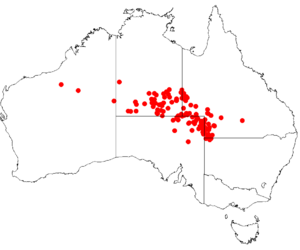Straggly corkbark facts for kids
Quick facts for kids Straggly corkbark |
|
|---|---|
| Scientific classification | |
| Genus: |
Hakea
|
| Species: |
eyreana
|
 |
|
| Occurrence data from AVH | |
The Hakea eyreana, also known as the straggly corkbark, is a special type of tree. It belongs to the plant family called Proteaceae. This tree is endemic to Australia, meaning it grows naturally only in the dry, inland parts of the country. It has unique needle-shaped leaves, flowers that are greenish-yellow, and fruits that look like oblongs or eggs.
What Does It Look Like?
This tree can be bushy or slender. It usually grows to be about 2 to 7 meters (6.5 to 23 feet) tall. A cool thing about it is that it can grow back from its base if it gets damaged. Its small branches are covered in dense white hairs.
The leaves of the straggly corkbark are shaped like needles and are about 1.5 to 9.5 centimeters (0.6 to 3.7 inches) long.
Flowers and Fruit
The Hakea eyreana blooms from May to November. During this time, it produces many greenish-yellow flowers. These flowers grow in clusters called inflorescences (say: in-flor-ESS-ens-ez) right where the leaves meet the stem. Each cluster can have between 35 and 105 flowers!
After the flowers, the tree grows woody fruits. These fruits are smooth and have an oblong or egg shape. They are about 2.5 to 4.2 centimeters (1 to 1.7 inches) long and have a long, pointy tip, like a beak. Inside, the seeds take up most of the space and have a wing on one side.
Where Does It Grow?
The straggly corkbark tree is found only in certain dry areas of Australia. These include parts of the Simpson Desert and Channel Country. You can find it in the states of South Australia, New South Wales, Queensland, and the Northern Territory.
It likes to grow in sandy or stony soils. You might see it on sand dunes, flat sandy areas, low spots between dunes called swales, or on flat, stony plains known as gibber flats.
How People Use It
The flowers of the Hakea eyreana are full of a sweet liquid called nectar. There's so much nectar that you can even sip it with a straw! People also mix this nectar with water to make a sweet drink.

